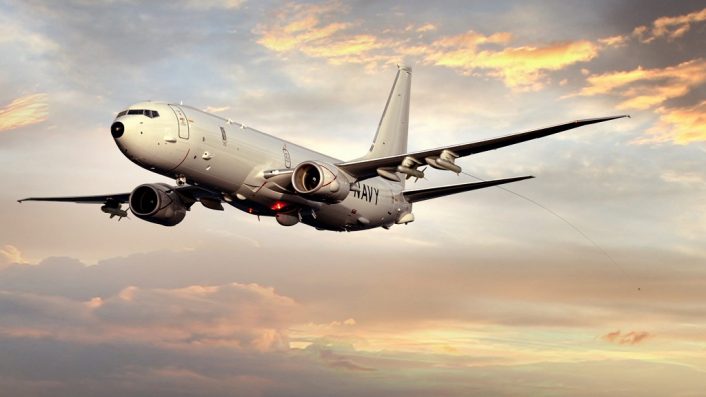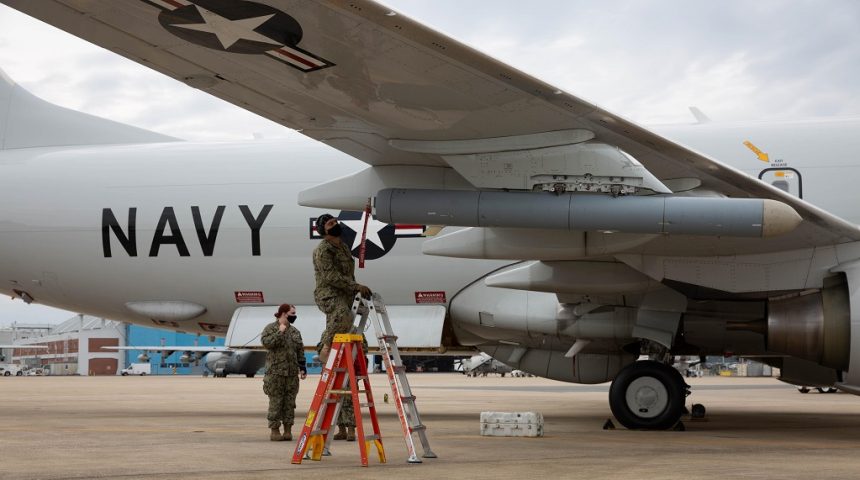The purpose-built pod for the P-8A Poseidon was developed from the experience with the ALE-55 Fiber-Optic Towed Decoy already used by the F/A-18E/F Super Hornet.
NAVAIR (Naval Air Systems Command) recently announced that a new pod-mounted radio frequency countermeasure (RFCM) prototype was tested on a P-8A Poseidon from Air Test and Evaluation Squadron (VX) 20 at the Naval Air Warfare Center Aircraft Division (NAWCAD) Atlantic Test Ranges. This test, which happened on Mar. 12, 2021, successfully validated the airworthiness of the specially designed pod that will allow the P-8A Poseidon to use towed decoys to defend against enemy radio frequency missile attacks.
“This has the potential to be a game-changer for protecting the warfighter,” said Capt. Eric Gardner, program manager for the Maritime Patrol and Reconnaissance Aircraft Program Office (PMA-290). “We continue to look for ways to enhance capabilities that allow the fleet to be successful.”
According to the press release, the pod was brought into the testing phase in just over a year thanks to a complete team effort involving PMA-290, the Advanced Tactical Aircraft Protection Systems Program Office (PMA-272), the Rapid Prototyping, Experimentation & Demonstration (RPED) team and the NAWCAD Aircraft Prototype Systems Division (APSD), after PMA-290 started looking for a solution to a potential threat from surface-to-air radio frequency missiles.
The teams from the Navy were also joined by BAE Systems, which was awarded a $4 million Other Transactions Authority (OTA) contract to develop and demonstrate the internal equipment of the RFCM pod, allowing a critical reduction of the amount of time and resources needed for this new self-protection technology to transition from prototype to fleet capability.
“The ability to meet this unprecedented response time underscores our agility, focus on meeting customer needs, and our ultimate goal of protecting our warfighters,” said Don Davidson, director of the Advanced Compact Electronic Warfare Solutions product line at BAE Systems. “A process that used to take 18 to 24 months has been scaled to five or six months, which is remarkable, as is deploying this new self-protection capability.”

The basic concept behind the pod’s development was a quick and simple solution, as the shell designed for the pod is based on the AGM-84 Harpoon anti-ship missile already certified for employment with the P-8A Poseidon and for which plenty of data is available, reducing the length of the integration process. The shell was then completed with the addition of the tracks and housing needed to fit and deploy the proven AN/ALE-55 Fiber Optic Towed Decoy, together with a small form factor jammer and a high-powered amplifier.
“A lot of the challenge and effort went into designing, to our best estimates, for what BAE was expected to put in the pod,” said Michael Hansell, the leading APSD engineer for the project. “We had to adapt and redesign rapidly. We worked as fast as possible to support PMA-290 and RPED to make sure we could pivot and adjust to meet established timelines.”
The ALE-55 fiber-optic towed decoy is a highly advanced RF self-protection jammer that is already operational with the U.S. Navy F/A-18E/F Super Hornet and EA-18G Growler fleets and has been proven to be highly-effective against RF missile threats. The ALE-55 towed decoy, as the name says, is a compact jammer towed by a fiber-optic cable which works together with the aircraft’s onboard Electronic Warfare (EW) system, jamming signals from incoming missiles with a high-powered response and guiding them safely away from the aircraft to the towed decoy. After the decoy is hit by the missile, the aircraft can then cut the towing cable and deploy another decoy if needed.
The Naval Innovative Science & Engineering (NISE) program provided the funds for the project, allowing to conceptualize, prototype, build, and test this new capability for the Navy and accelerating the design and manufacturing cycle for the prototype to just under six months. Additional time was saved also thanks to PMA-272, which made available its F/A-18 lab equipment to test the pod’s systems.
“This shows that when we identify a need and work rapidly as a team we can bring a viable solution to test that has the ability to greatly impact the warfighter,” said Lt. Cmdr. Mike Marschall, PMA-290 weapons and rapid capabilities co-team lead.
Following the successful airworthiness test, the pod was transferred about a week later to Naval Air Weapons Station China Lake (California) where, according to the press release, it successfully completed effectiveness testing from March 21 through 26, ahead of further system level testing that will allow the pod to be fully integrated on the P-8A Poseidon through planned capability fielding phases.









